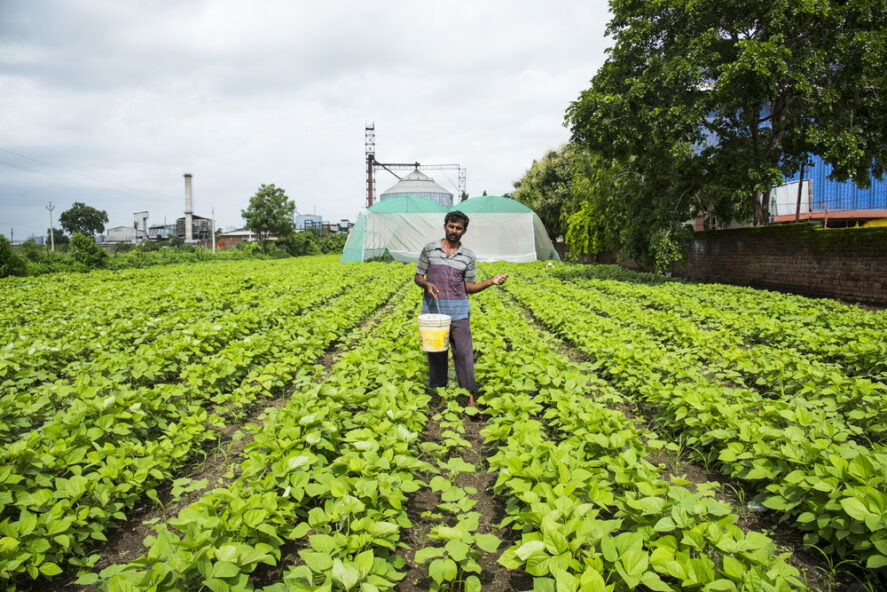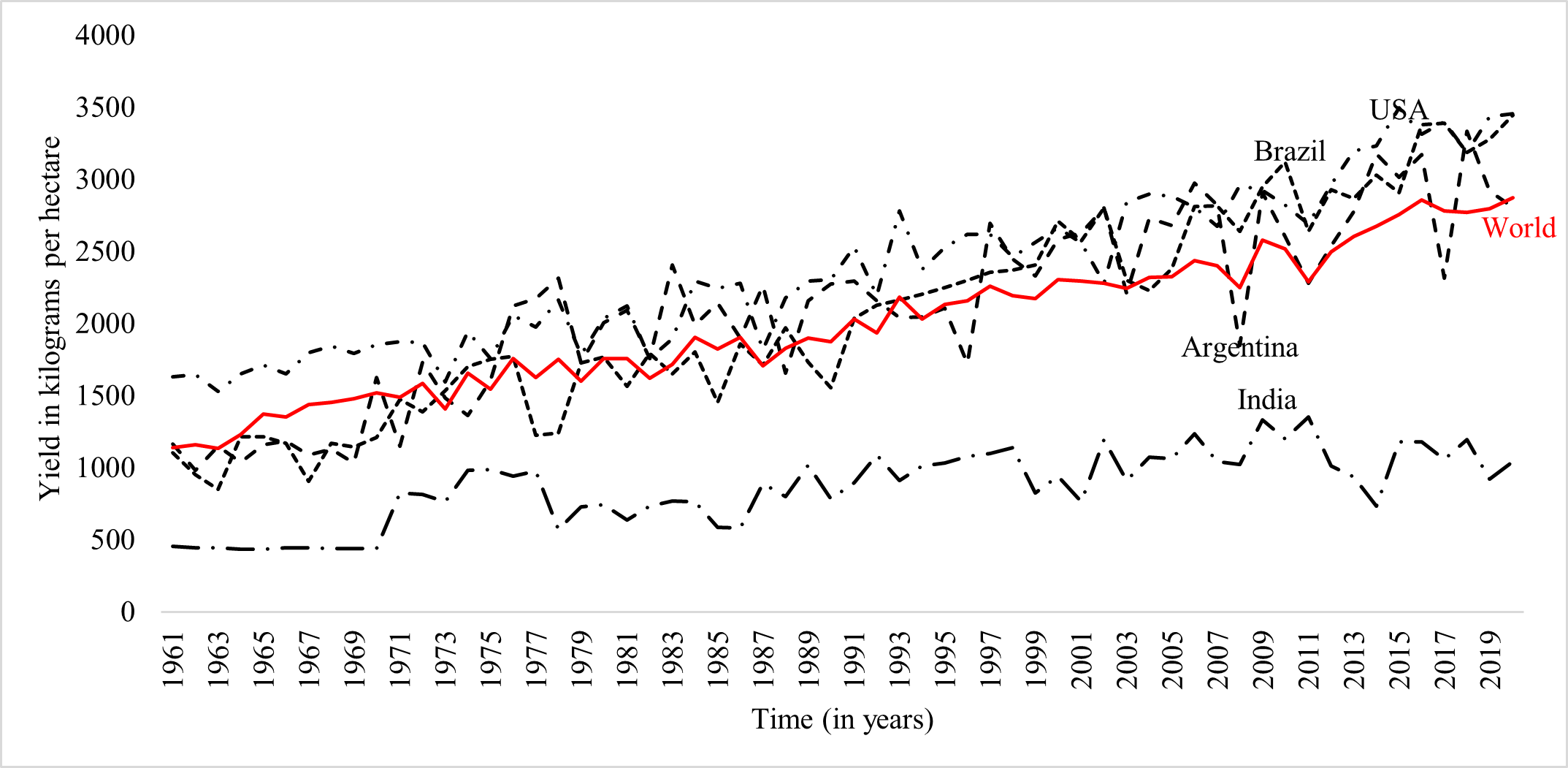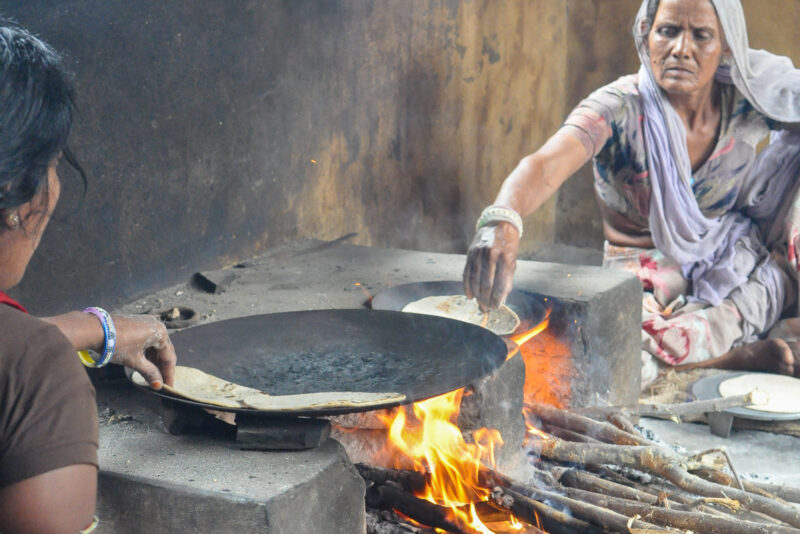Accelerating Varietal Turnover in Smallholder Soybean Farms

Historically, shifting to improved varieties played an essential role in increasing yields by 50–90% in different crops and proved to be an effective instrument for boosting farm incomes, enhancing household consumption, improving asset ownership, and reducing poverty. However, frequent varietal replacement is essential for farmers and consumers to benefit from advancements in breeding research.
The burgeoning global demand for multiple uses of soybeans spurs continuous expansion in the area and production of soybeans in India. However, the enormous demand for soybeans is met primarily by bringing more area under cultivation rather than improving yields and breaking yield barriers. Transitioning to faster breeding cycles and quicker varietal turnover can circumvent these hurdles and spur production with the same level of input use.
In our new study published in the Journal of Cleaner Production, we examine the current rate of soybean varietal replacement and analyzed the factors that could be used to accelerate it. We calculate the varietal age for 1,410 smallholder soybean farms and the drivers of varietal change, leveraging duration analysis to simultaneously examine the diffusion pattern of existing varieties and farm-level varietal shift accelerators. The study shows that the slow varietal replacement in soybeans in India can be accelerated by the quicker release of new improved varieties with desired traits (namely higher genetic yield potential), enhanced information flow, and prioritizing breeding efforts to address farmers’ preferences for traits like drought tolerance and fodder palatability. We find that a lack of breeding efforts for long juvenility (needed to avoid precocious flowering, which leads to reduced biomass in the lower latitudes of India), drought tolerance, and fodder palatability hamper varietal change. Encouraging private-sector breeding and modern molecular methods will play a critical role in these efforts.

Soybean yield in India vis-à-vis other countries and the global average (Kgs/Ha)
Source: Indian Ministry of Agriculture and Farmers’ Welfare, 2018
Smallholder soybean farms in India
Six million smallholders cultivate soybeans across 13.1 million hectares in central and western India in the states of Madhya Pradesh and Maharashtra. In the late 1960s, under a University of Illinois-USAID program, the Indian government introduced yellow soybeans for rainfed cultivation as a less risky, short-duration crop to utilize fallow monsoon lands. Average soybean yields then grew from 438 kilograms per hectare to 1,015 in 1990-91, but have stagnated over the last three decades. One of the reasons for this is that farmers continue to grow only a few mega varieties, like JS-335 and JS-9560. This logjam in adopting new, improved varieties has led not only to plateaued yields, but slower poverty reduction and adverse nutritional outcomes.
Limited varietal choices and long average age of varieties
The sampled soybean farmers were smallholders with an average landholding of 4.63 acres, poor education, and insufficient infrastructure facilities. A significant number of the farmers came from disadvantaged social groups.
The weighted average age of soybean varieties used by the farmers is 15.6 years. This reflects a slow replacement of varieties that significantly overshoots the 10-year cutoff after which farmers lose the benefits of genetic improvements made through continuous research. The farmers’ range of choices is limited, with only nine varieties in the seed chain. Two of those varieties—developed in “selection cycle-2” of breeding after 1990—occupy more than four-fifths of the sown area.
Drivers for accelerating varietal turnover
Our analysis shows that the availability of new varieties drives varietal turnover more than any other variable. Farmers stick with the existing, proven varieties because varietal options with more desirable traits remain low. Sixty-one percent of farmers reported a preference for improved yield traits, but with the failure of breeding efforts to break yield barriers and achieve higher genetic potential, our analysis found that low yields do not accelerate varietal replacement. Beyond yield, the farmers also report a preference for varieties with improved fodder palatability and drought tolerance.
Another important finding is that the drivers of varietal turnover for soybean farmers differ between the two study regions. Information flow through the input dealers promotes varietal turnover in central India but slows it down in western India. Soybean farmers in West India prefer pest resistance for quicker variety replacement.
Our findings imply an elevated role for farming-related information access through public, private, media, and social learning routes. However, information from public extension agencies does not impact varietal turnover on the whole. The higher segmentation among the sampled households and large share of disadvantaged social groups like scheduled castes and scheduled tribes results in slower information flow. Research studies show that information flow about new agricultural technologies among farm households is hindered in agrarian societies plagued by caste divisions. More effective information flow requires more events like agricultural shows, exhibitions, and other participatory events, with special attention to demand-driven, technology-related information.
Policy implications
Our findings have crucial implications for improving varietal turnover speeds and breaking the yield plateau in smallholder soybean farms. There is a pressing need to accelerate breeding efforts with short breeding cycles through greater public investment, the application of modern molecular methods, and private sector encouragement. It is crucial to focus breeding efforts on incorporating long juvenility with photo-insensitivity to cultivate soybeans successfully at lower latitudes in India. India can emulate the biotechnological soybean successes of Brazil, the US, and Argentina. A recently released drought-tolerant soybean in Argentina is particularly relevant, as soybean is primarily cultivated as a rainfed crop without irrigation in India.
To foster private sector efforts, a level playing field is required. This can be achieved by permitting germplasm imports, new molecular breeding technologies, and hybridization, as well as delisting obsolete varieties after more than 10 years. It is imperative to alter breeding priorities to include traits like long juvenility, drought tolerance, and fodder palatability, taking into account regional variations in farmer preferences.
Through imports and the utilization of modern genetic tools, India can address the poor genetic diversity of its soybean varieties, benefiting both producers and consumers of this in-demand crop alike.
Chandra S. Nuthalapati is a visiting professor at TCI and a professor of economics at the Institute of Economic Growth in New Delhi, India.
Featured image: A farmer distributes fertilizer onto his soybean crops in Maharashtra, India. (Photo by CRS Photo/Shutterstock)





